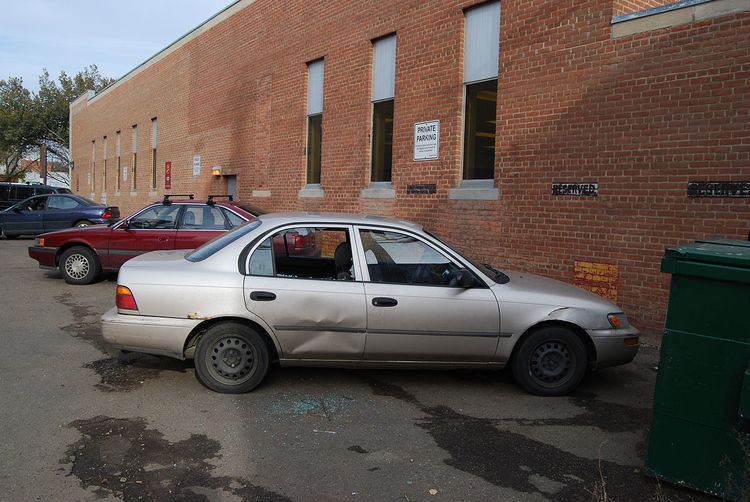 | ||
Motor vehicle theft or, grand theft auto, is the criminal act of stealing or attempting to steal a car (or any other motor vehicle). Nationwide in the US in 2012, there were an estimated 721,053 motor vehicle thefts, or approximately 229.7 motor vehicles stolen for every 100,000 inhabitants. Property losses due to motor vehicle theft in 2012 were estimated at $4.3 billion.
Contents
Methods
Some methods used by criminals to steal motor vehicles include:
Commonly used tools
Vehicles most frequently stolen
The makes and models of vehicles most frequently stolen vary by several factors, including region and ease of theft. In particular, the security systems in older vehicles may not be up to the same standard as current vehicles, and thieves also have longer to learn their weaknesses. Scrap metal and spare part prices may also influence thieves to prefer older vehicles.
In Bangkok, Thailand, the most frequently stolen vehicles are Toyota cars, Toyota Hilux and Isuzu D-Max pickups.
In Malaysia, Proton models are the most frequently stolen vehicles, with Proton Wira being the highest, followed by the Proton Waja and the Proton Perdana.
Prevention
There are various methods of prevention to reduce the likelihood of a vehicle getting stolen. These include physical barriers, which make the effort of stealing the vehicle more difficult. Some of these include:
Recovery of stolen vehicles
Recovery rates for stolen vehicles vary, depending on the effort a jurisdiction's police department puts into recovery, and devices a vehicle has installed to assist in the process.
Police departments use various methods of recovering stolen vehicles, such as random checks of vehicles that come in front of a patrol unit, checks of all vehicles parked along a street or within a parking lot using automatic number plate recognition (ANPR) or keeping a watchlist of all the vehicles reported stolen by their owners. Police departments also receive tips on the location of stolen vehicles through StolenCar.com or isitnicked.com in the United Kingdom. Reason being is that car thieves will abandon a hot vehicle on a street or parking lot to let it cool off before moving it again in case it has a tracking device. Another method car thieves use is dismantle the car as soon as they can which makes recovery hard or by border crossing to another state or country making the BOLO watch list obsolete.
In the UK, the Driver and Vehicle Licensing Agency (DVLA) provides information on the registration of vehicles to certain companies for consumer protection and anti-fraud purposes. The information may be added to by companies with details from the police, finance and insurance companies. Such companies include Carfax in the US, AutoCheck and CarCheck in the United Kingdom, and Cartell in Ireland, which then provide online car check services for the public and motor trade.
Vehicle tracking systems, such as LoJack, Automatic vehicle location, or Onstar may enable the location of the vehicle to be tracked by local law enforcement or a private company. Other security devices such as DotGuard microdots allow individual parts of a vehicle to also be identified and potentially returned.
Motor vehicle thefts, by country
Criminologist Frank E. Hagan wrote that, "Probably the most important factor in the rate of motor vehicle theft is the number of motor vehicles per capita in the country." Using data supplied by the United Nations Office on Drugs and Crime, the estimated worldwide auto-theft rate is 65.8 per 100,000 residents. However, data is not available for all countries, and this crime rate reflects only the most recent year of reported data. For the 4,429,167,344 people these countries represent, there were a total 2,915,575 cars stolen. Uruguay has the highest auto-theft rate for any fairly large country in the world, at 437.6 per 100,000 residents in 2012. However Bermuda in its most recent year of reported auto-thefts (2004), reported a rate of 1324.0 per 100,000 people. But the small population of Bermuda (65,000) is smaller than many cities in countries such as the USA or Canada. Some cities have higher rates than Bermuda, such as Newark, NJ which had an auto-theft rate of 1420.6 in 2012.
The United Nations Office on Drugs and Crime notes "that when using the figures, any cross-national comparisons should be conducted with caution because of the differences that exist between the legal definitions of offences in countries, or the different methods of offence counting and recording". The last thing to note is that crime will vary by certain neighborhoods or areas in each country, so, just because a nationwide rate is a specified rate, does not mean that everywhere in that country retains the same amount of the likelihood of a car to be stolen.
